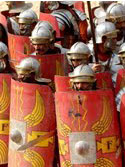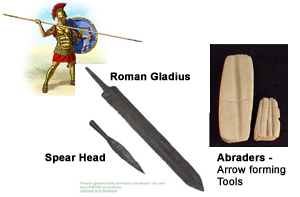Military Resource

Warfare,
Warriors & Empires.
| Ancient Military | ||||
|
Ancient Empires
|
||||
 |
||||
Roman manufacturing supplied massive armies, uncompasing around 75% of the governments budget. |
||||
Ancient Weapon Manufacturing |
 |
||||
| The manufacturing of weapons was instrumental to the survival of ancient groups and culture, not just for hunting, also due to the war like nature of humanity. Manufacturing in the ancient world was typically a cottage industry. Literally, a cottage industry. An early metal smith was considered to be a person with an incredible, almost magical power. Early metal workers were highly valued members of society, their trade could mean the life or death of a tribe for example. The secrets of working with metals would have been passed down to an apprentice. Eventually, this evolved into small shops that could turn out quality arms and armor. However, a few step would be necessary to arm something like the 100,000 man armies of the Roman Empire. |
|||||
Ancient manufacturing skills meant the rise and fall of ancient tribes, societies and empires as we advanced from stone tooling to carbide dies. |
|||||
History of Tooling, Industry and ManufacturingThe Beginning of Manufacturing There is a theme that many modern historians enjoy that likes to point out that the Romans had some cultural jealousy towards the Greeks but this certainly didn’t apply to the military. In the area of warfare the Romans definitely didn’t have an inferiority complex. The Romans used steel to make their famous swords, the gladius, and employed government agents to ensure that the weapons and armor of the Roman armies would be standardized. While at first the military contracts for weapons and armor were fulfilled by private entrepreneurs they eventually became state run enterprises. In the late empire each massive field army had its own state owned armament facility in key locations. These large field armies were tasked with countering any large enemy excursions into Roman territory. Field armies retained production capabilities themselves, but largely became dependent on these government facilities for equipping them. The Romans made further advancement in weapon and armor standardization and although their military products weren’t as elegant and refined as our reproductions, they really only cared about efficiency. The Romans used something similar to modern carbide dies to draw the shafts of their pilum (heavy javelins) and developed such things as standardized metal plate armor. However, the next step in industrialization was never achieved, the Romans were stagnated and fell before they could achieve true industrialization. The next notable leap wasn’t until the Venice Arsenal, owned by the Republic of Venice, perhaps the first place to qualify as a factory by many modern standards. The Venice Arsenal, found in 1104 was several hundred years before the industrial revolution but had 16,000 employees at its height. They used prefabricated, standardized parts to produce ships and other war goods on assembly lines. At its height it could launch a ship a day. Once the industrial revelation hit full swing, things were mechanized, but this wouldn’t be until beyond the scope of ancient military production. . |
|||||